It is the eighth day of Cinefest, the 17th International Festival of German Film-Heritage and it is the first day of the international conference. How was the Netherlands represented in German cinema? Frau Antje is the most famous Dutch woman in Germany. She was conceived by the Dutch Dairy Bureau in the 1960s. A radiant woman with a Volendam hat who recommends the Dutch dairy products in Germany. There this fictional advertising figure developed from a cheese girl into the symbol of the Netherlands. Frau Antje was the successor of all these girls in traditional Dutch costumes in countless international films. On one of the festival cards, Sonja Ziemann as one of the precursors of Frau Antje kisses Gunnar Möller in Hollandmädel/Dutch Girl (J. A. Hübler-Kahla, 1953).

German postcard by Kunst und Bild, Berlin, no. A 813. Photo: Arthur Grimm, Berlin / CCC-Film. Sonja Ziemann in Hollandmädel/Dutch Girl (J.A. Hübler-Kahla, 1953).
Delicately lovely, dark-haired, and innocent-looking Sonja Ziemann (1926-2020) was a German film and television actress, singer, and dancer. Her roles in film operettas and Heimatfilms as Schwarzwaldmädel/The Black Forest Girl (Hans Deppe, 1950) and Grün ist die Heide/The Heath is Green (Hans Deppe, 1951) made her one of the first stars of Germany's post-war cinema. Her private life knew several tragedies.
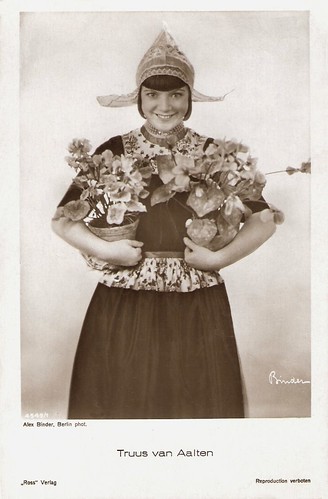
German postcard by Ross Verlag, no. 4549/1, 1929-1930. Photo: Alex Binder, Berlin.
Dutch film star Truus van Aalten (1910-1999) made 29 films in the 1920s and 1930s, and only one of them in the Netherlands.
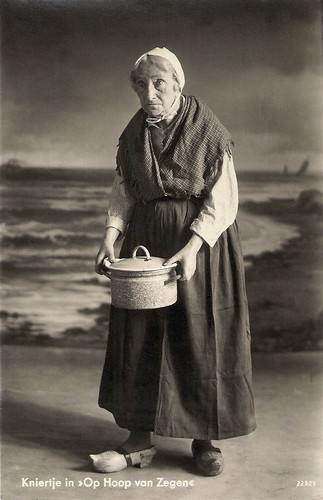
Dutch postcard by Foto-Industrie De Voorkeur, Amsterdam, no 22927. Photo: Leenheer. Esther de Boer-van Rijk in her Kniertje costume.
Esther de Boer-van Rijk (1853-1937) was the most popular Dutch actress ever. She was a national icon as the tragic fisherwoman Kniertje in the stage classic 'Op hoop van zegen' (The Good Hope) by Herman Heijermans and played the role again in both a silent (1918) and a sound film version (1934). She also appeared in a dozen other Dutch silent films.
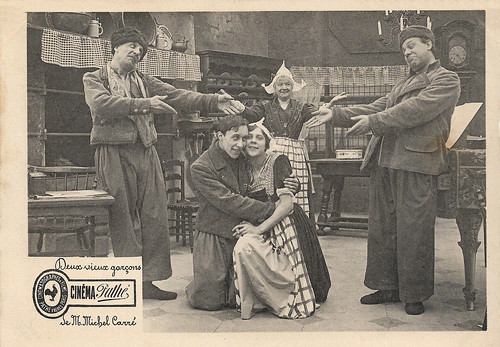
Big French photo card by Cinéma Pathé. Photo: SCAGL. Andrée Marly in Deux vieux garçons/Two old boys (Michel Carré, 1911).
Andrée Marly is kneeling in the middle. Her lover is played by Charles Maudru. The two old men, courting young Katje in vain, and finally giving in, are Louis Baron fils and Georges Coquet. The woman in the back is Marie Ernestine Desclauzas. In real life, Marly was married to Coquet. The setting and costumes in this film refer to the popular Dutch village of Volendam.

Italian promotion postcard for Philips. Photo: Emrik & Binger, Haarlem. Captions: Philips, Eindhoven (Olanda). Ragazza Olandese (Dutch girls), no.11. Lampada Philips, Risparmio 75%, Luce Bianchissima.
Annie Bos aka Anny Bos (1886-1975) was a Dutch actress in theatre and film. She was known as the queen of the Dutch silent film, between 1912 and 1924. Bos was entitled "Holland’s most famous film actress" and the first Dutch film diva. Bos appeared in a traditional costume in the Dutch film Mooi Juultje van Volendam/Beautiful Juultje from Volendam (Alex Benno, 1924) and she was one of the traditional Dutch girls in a postcard campaign by the Philips factories.
Even before the cinema, from the late 19th century, the Netherlands was a popular place for German painters. The works of Max Liebermann, Hans von Bartels, and Fritz von Uhde point to this.
They fell not only on the treasures from Holland's Golden Age of the 17th century in the museums, but also on the picturesque qualities of the country, the light and clouds on the Dutch coast, the archaic fishing villages on the North Sea (Katwijk) and the former Zuiderzee (Volendam, Marken) in a time of the industrial revolution, the picturesque folk costumes, art colonies like in Laren and Bergen, and the old cityscapes and canals of Amsterdam and Dordrecht.
German cinema immediately picked up on and expanded this picturesque vision, either shooting film dramas on location in Volendam and Marken or using either a contemporary or historical studio version of Amsterdam or the Dutch fishing villages.
Fishing dramas have been associated with strong emotional reactions and disasters such as shipwrecks.
This remained so in Berlin in the 1920s with films by Dutch directors, for example with the lost film adaptation Die Fahrt ins Verderben (James Bauer, 1924), in which the Rotterdam-born German actress Adele Sandrock played the leading role. It was based on an often filmed popular Dutch play, 'Op Hoop van Zegen'.
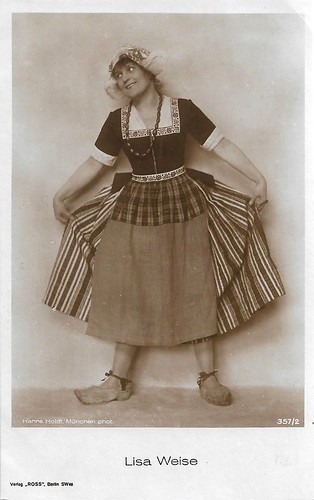
German postcard by Verlag Ross, no. 357/2. Photo: Hanna Holdt, München. Perhaps this card refers to the film Klein Doortje/Little Dorit (Friedrich Zelnik, 1917), which takes place in the Netherlands.
German actress Lisa Weise (?-1952) starred in silent films of the 1910s. Most of her films were directed by Friedrich Zelnik and often her film partner was Karl Beckersachs.

German postcard by Ross Verlag, no. 259/3. Photo: Becker & Maass / May-Film. Mia May in Fünf Minuten zu spät/Five minutes late (Uwe Jenss Krafft, 1918).
Mia May wears the typical bonnet of the Dutch fisherman's village of Volendam. Her character's name, Jana Vermöhlen, sounds like a German transcription of Janna Vermeulen. Janna is a common old-styled Dutch female name, while Vermeulen is a common Dutch last name.

Italian postcard by Casa Editrice Ballerini & Fratini, Firenze (B.F.F. Editore), no. 373. Photo: Metro-Goldwyn, Roma. Marion Davies and Owen Moore in The Red Mill (Roscoe 'Fatty' Arbuckle (as William Goodrich), 1927).
Marion Davies (1897-1961) was one of the great comedic actresses of the silent era. She starred in nearly four dozen films between 1917 and 1937.

German postcard by Ross Verlag, no. 1852/2, 1927-1928. Photo: Fox. Janet Gaynor as Dutch farmer girl, 'Volendammer' style.
Petite Janet Gaynor (1906-1984) was the innocent-eyed, round-faced Hollywood star who won the first Academy Award for best actress for her roles in three silent films. She went on to become a leading performer in talking pictures, and was one of the most popular Hollywood leading ladies in the 1920s and 1930s. By 1934 she was receiving a yearly salary of $252,583 from Fox, making her Hollywood's most highly paid actress.

German Postcard by Ross Verlag, no. 109/1. Photo: Henny Porten Film. Henny Porten in Die Frau, die jeder liebst, bist Du/The woman everyone loves is you (Carl Froehlich, 1929).

German Postcard by Ross Verlag, no. 109/3. Photo: Henny Porten-Froehlich Produktion (HPF). Henny Porten in Die Frau, die jeder liebst, bist Du (Carl Froehlich, 1929).
Sturdy and blond Henny Porten (1890-1960) was one of Germany's most important and popular film actresses of the silent cinema. She became the quintessence of German womanhood, ladylike yet kindhearted and a not a little petit bourgeois. She was also the producer of many of her own films.
The 33rd International Film History Congress is part of the Cinefest festival. During this congress, the topics of the festival are deepened in lectures and discussions.
Due to the popularity of German films in the Netherlands as early as the 1910s, many copies of early German cinema have survived in the collection of distributor Jean Desmet, preserved by EYE in Amsterdam.
Especially for the Cinefest festival EYE put several of these films online. (See the Desmet playlist on YouTube).
Other conference themes are the representation of the Netherlands in German cinema, the representation of the German occupation of the Netherlands in film, and the 1930s Exil Cinema in the Netherlands
The congress opened on 19 November 2020 and takes place from 20-22 November 2020, from 9:30 a.m. to 4:00 p.m., online.

German postcard by Ross Verlag, no. 3413/1. Photo: Defina / Defu. Lya Mara in Heut tanzt Mariett (Friedrich Zelnik, 1928).

German postcard by Ross Verlag, no. 4308/4, 1929-1930. Photo: Ernst Schneider, Berlin.
Lya Mara (1897-1960?) was one of the biggest stars of the German silent cinema. Her stardom was even the subject of a novel, which was published in 100 episodes between 1927 and 1928. Her career virtually ended after the arrival of sound film.

German postcard by Ross Verlag, no. 5315/1, 1930-1931. Photo: Ufa. Collection: Geoffrey Donaldson Institute.
Dutch actress Lien Deyers (1910-1965) - also known as Lien Deijers and Lien Dyers - was discovered by famous director Fritz Lang who gave her a part in his film Spione/Spies (1928). She acted in a stream of late silent and early sound films. After 1935 her star faded rapidly and her life ended in tragedy.

Dutch postcard by JosPe, Arnhem. Photo: Maurice Chevalier in Volendam. This picture was taken in 1932 when The French singer and actor visited the Netherlands.
The trademark of French actor, singer, and entertainer Maurice Chevalier (1988-1972) was his casual straw hat, which he always wore on stage, plus a cane and a tuxedo. His signature songs included 'Louise', 'Mimi', and 'Thank Heaven for Little Girls'. For the cinema, he worked with such directors as Max Linder, Ernst Lubitsch, Ludwig Berger, René Clair, and Vincente Minelli. His heavy French accent, melodic voice, and Gallic charm made him the prototype of the gallant French monsieur in the Hollywood cinema of the 1930s.

German postcard by Ross Verlag, no. A 1462/1, 1937-1938. Photo: Paramount. Franziska Gaal in The Buccaneer (Cecil B. DeMille, 1938).
Popular Hungarian cabaret artist and theatrical actress Franziska Gaál (1904-1973) starred in several European films of the 1920s and 1930s. Later she went to Hollywood to star in Cecil B. DeMille's The Buccaneer (1938) and other films.
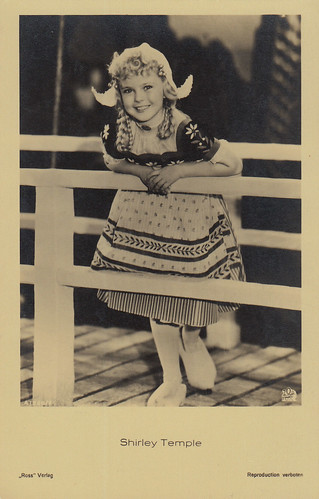
German postcard by Ross Verlag, no. A 1538/6, 1937-1938. Photo: 20th Century Fox. Shirley Temple in Heidi (Allan Dwan, 1937). She's wearing the costume in the fairytale music dance sequence Magic Wooden Shoes: "Once there was a Dutch girl ..."
Shirley Temple (1928-2014) was an American film and television actress, singer, dancer, and public servant, but everybody knows her as the most famous child star in the 1930s. Shirley could do it all: act, sing, and dance and all at the age of five! Four years in a row, between 1935 and 1938, she was the top box-office draw for Hollywood. As an adult, she entered politics and became a diplomat, serving as United States Ambassador to Ghana and later to Czechoslovakia, and as Chief of Protocol of the United States.

French postcard by Cinémagazine-Edition, Paris, no. 850. Photo: Films Paramount. Collection: Marlene Pilaete.
American actress Clara Bow (1905-1965) rose to stardom in silent film during the 1920s. It was her appearance as a plucky shopgirl in the film It (Clarence G. Badger, 1927) that brought her global fame and the nickname 'The It Girl'. Bow came to personify the Roaring Twenties and is described as its leading sex symbol.
Ossi Oswalda, Victor Janson and other German film artists, who were in the Netherlands for the Dutch premiere of Die Wohnungsnot/The Housing Shortage (Ernst Lubitsch, 1920) make a trip to Volendam. Source: Eye Filmmuseum(YouTube).

German postcard by Ross Verlag, no. 6436/1, 1931-1932. Photo: Atelier Gerstenberg, Berlin.
Dutch film star Truus van Aalten (1910-1999) made 29 films in the 1920s and 1930s, and only one of them in the Netherlands.

German promotion card for Cinegraph 'Kino, Krief und Tulpen: Deutsch-Niederländische Filmbeziehungen' (Cinema, War, and Tulips - German-Dutch Film Relations) by Cinefest / Bundelsfilmarchiv, 2002. Photo: Sonja Ziemann and Gunnar Möller in Hollandmädel/Dutch Girl (J.A. Hübler-Kahla, 1953).
Sources: Sophie Elpers (Hollandser dan kaas - Dutch), Ivo Blom (Cinefest catalogue), and Cinefest.

German postcard by Kunst und Bild, Berlin, no. A 813. Photo: Arthur Grimm, Berlin / CCC-Film. Sonja Ziemann in Hollandmädel/Dutch Girl (J.A. Hübler-Kahla, 1953).
Delicately lovely, dark-haired, and innocent-looking Sonja Ziemann (1926-2020) was a German film and television actress, singer, and dancer. Her roles in film operettas and Heimatfilms as Schwarzwaldmädel/The Black Forest Girl (Hans Deppe, 1950) and Grün ist die Heide/The Heath is Green (Hans Deppe, 1951) made her one of the first stars of Germany's post-war cinema. Her private life knew several tragedies.

German postcard by Ross Verlag, no. 4549/1, 1929-1930. Photo: Alex Binder, Berlin.
Dutch film star Truus van Aalten (1910-1999) made 29 films in the 1920s and 1930s, and only one of them in the Netherlands.

Dutch postcard by Foto-Industrie De Voorkeur, Amsterdam, no 22927. Photo: Leenheer. Esther de Boer-van Rijk in her Kniertje costume.
Esther de Boer-van Rijk (1853-1937) was the most popular Dutch actress ever. She was a national icon as the tragic fisherwoman Kniertje in the stage classic 'Op hoop van zegen' (The Good Hope) by Herman Heijermans and played the role again in both a silent (1918) and a sound film version (1934). She also appeared in a dozen other Dutch silent films.

Big French photo card by Cinéma Pathé. Photo: SCAGL. Andrée Marly in Deux vieux garçons/Two old boys (Michel Carré, 1911).
Andrée Marly is kneeling in the middle. Her lover is played by Charles Maudru. The two old men, courting young Katje in vain, and finally giving in, are Louis Baron fils and Georges Coquet. The woman in the back is Marie Ernestine Desclauzas. In real life, Marly was married to Coquet. The setting and costumes in this film refer to the popular Dutch village of Volendam.

Italian promotion postcard for Philips. Photo: Emrik & Binger, Haarlem. Captions: Philips, Eindhoven (Olanda). Ragazza Olandese (Dutch girls), no.11. Lampada Philips, Risparmio 75%, Luce Bianchissima.
Annie Bos aka Anny Bos (1886-1975) was a Dutch actress in theatre and film. She was known as the queen of the Dutch silent film, between 1912 and 1924. Bos was entitled "Holland’s most famous film actress" and the first Dutch film diva. Bos appeared in a traditional costume in the Dutch film Mooi Juultje van Volendam/Beautiful Juultje from Volendam (Alex Benno, 1924) and she was one of the traditional Dutch girls in a postcard campaign by the Philips factories.
The archaic fishing villages on the North Sea and the former Zuiderzee
Even before the cinema, from the late 19th century, the Netherlands was a popular place for German painters. The works of Max Liebermann, Hans von Bartels, and Fritz von Uhde point to this.
They fell not only on the treasures from Holland's Golden Age of the 17th century in the museums, but also on the picturesque qualities of the country, the light and clouds on the Dutch coast, the archaic fishing villages on the North Sea (Katwijk) and the former Zuiderzee (Volendam, Marken) in a time of the industrial revolution, the picturesque folk costumes, art colonies like in Laren and Bergen, and the old cityscapes and canals of Amsterdam and Dordrecht.
German cinema immediately picked up on and expanded this picturesque vision, either shooting film dramas on location in Volendam and Marken or using either a contemporary or historical studio version of Amsterdam or the Dutch fishing villages.
Fishing dramas have been associated with strong emotional reactions and disasters such as shipwrecks.
This remained so in Berlin in the 1920s with films by Dutch directors, for example with the lost film adaptation Die Fahrt ins Verderben (James Bauer, 1924), in which the Rotterdam-born German actress Adele Sandrock played the leading role. It was based on an often filmed popular Dutch play, 'Op Hoop van Zegen'.

German postcard by Verlag Ross, no. 357/2. Photo: Hanna Holdt, München. Perhaps this card refers to the film Klein Doortje/Little Dorit (Friedrich Zelnik, 1917), which takes place in the Netherlands.
German actress Lisa Weise (?-1952) starred in silent films of the 1910s. Most of her films were directed by Friedrich Zelnik and often her film partner was Karl Beckersachs.

German postcard by Ross Verlag, no. 259/3. Photo: Becker & Maass / May-Film. Mia May in Fünf Minuten zu spät/Five minutes late (Uwe Jenss Krafft, 1918).
Mia May wears the typical bonnet of the Dutch fisherman's village of Volendam. Her character's name, Jana Vermöhlen, sounds like a German transcription of Janna Vermeulen. Janna is a common old-styled Dutch female name, while Vermeulen is a common Dutch last name.

Italian postcard by Casa Editrice Ballerini & Fratini, Firenze (B.F.F. Editore), no. 373. Photo: Metro-Goldwyn, Roma. Marion Davies and Owen Moore in The Red Mill (Roscoe 'Fatty' Arbuckle (as William Goodrich), 1927).
Marion Davies (1897-1961) was one of the great comedic actresses of the silent era. She starred in nearly four dozen films between 1917 and 1937.

German postcard by Ross Verlag, no. 1852/2, 1927-1928. Photo: Fox. Janet Gaynor as Dutch farmer girl, 'Volendammer' style.
Petite Janet Gaynor (1906-1984) was the innocent-eyed, round-faced Hollywood star who won the first Academy Award for best actress for her roles in three silent films. She went on to become a leading performer in talking pictures, and was one of the most popular Hollywood leading ladies in the 1920s and 1930s. By 1934 she was receiving a yearly salary of $252,583 from Fox, making her Hollywood's most highly paid actress.

German Postcard by Ross Verlag, no. 109/1. Photo: Henny Porten Film. Henny Porten in Die Frau, die jeder liebst, bist Du/The woman everyone loves is you (Carl Froehlich, 1929).

German Postcard by Ross Verlag, no. 109/3. Photo: Henny Porten-Froehlich Produktion (HPF). Henny Porten in Die Frau, die jeder liebst, bist Du (Carl Froehlich, 1929).
Sturdy and blond Henny Porten (1890-1960) was one of Germany's most important and popular film actresses of the silent cinema. She became the quintessence of German womanhood, ladylike yet kindhearted and a not a little petit bourgeois. She was also the producer of many of her own films.
The survival of early German films in a Dutch collection
The 33rd International Film History Congress is part of the Cinefest festival. During this congress, the topics of the festival are deepened in lectures and discussions.
Due to the popularity of German films in the Netherlands as early as the 1910s, many copies of early German cinema have survived in the collection of distributor Jean Desmet, preserved by EYE in Amsterdam.
Especially for the Cinefest festival EYE put several of these films online. (See the Desmet playlist on YouTube).
Other conference themes are the representation of the Netherlands in German cinema, the representation of the German occupation of the Netherlands in film, and the 1930s Exil Cinema in the Netherlands
The congress opened on 19 November 2020 and takes place from 20-22 November 2020, from 9:30 a.m. to 4:00 p.m., online.

German postcard by Ross Verlag, no. 3413/1. Photo: Defina / Defu. Lya Mara in Heut tanzt Mariett (Friedrich Zelnik, 1928).

German postcard by Ross Verlag, no. 4308/4, 1929-1930. Photo: Ernst Schneider, Berlin.
Lya Mara (1897-1960?) was one of the biggest stars of the German silent cinema. Her stardom was even the subject of a novel, which was published in 100 episodes between 1927 and 1928. Her career virtually ended after the arrival of sound film.

German postcard by Ross Verlag, no. 5315/1, 1930-1931. Photo: Ufa. Collection: Geoffrey Donaldson Institute.
Dutch actress Lien Deyers (1910-1965) - also known as Lien Deijers and Lien Dyers - was discovered by famous director Fritz Lang who gave her a part in his film Spione/Spies (1928). She acted in a stream of late silent and early sound films. After 1935 her star faded rapidly and her life ended in tragedy.

Dutch postcard by JosPe, Arnhem. Photo: Maurice Chevalier in Volendam. This picture was taken in 1932 when The French singer and actor visited the Netherlands.
The trademark of French actor, singer, and entertainer Maurice Chevalier (1988-1972) was his casual straw hat, which he always wore on stage, plus a cane and a tuxedo. His signature songs included 'Louise', 'Mimi', and 'Thank Heaven for Little Girls'. For the cinema, he worked with such directors as Max Linder, Ernst Lubitsch, Ludwig Berger, René Clair, and Vincente Minelli. His heavy French accent, melodic voice, and Gallic charm made him the prototype of the gallant French monsieur in the Hollywood cinema of the 1930s.

German postcard by Ross Verlag, no. A 1462/1, 1937-1938. Photo: Paramount. Franziska Gaal in The Buccaneer (Cecil B. DeMille, 1938).
Popular Hungarian cabaret artist and theatrical actress Franziska Gaál (1904-1973) starred in several European films of the 1920s and 1930s. Later she went to Hollywood to star in Cecil B. DeMille's The Buccaneer (1938) and other films.

German postcard by Ross Verlag, no. A 1538/6, 1937-1938. Photo: 20th Century Fox. Shirley Temple in Heidi (Allan Dwan, 1937). She's wearing the costume in the fairytale music dance sequence Magic Wooden Shoes: "Once there was a Dutch girl ..."
Shirley Temple (1928-2014) was an American film and television actress, singer, dancer, and public servant, but everybody knows her as the most famous child star in the 1930s. Shirley could do it all: act, sing, and dance and all at the age of five! Four years in a row, between 1935 and 1938, she was the top box-office draw for Hollywood. As an adult, she entered politics and became a diplomat, serving as United States Ambassador to Ghana and later to Czechoslovakia, and as Chief of Protocol of the United States.

French postcard by Cinémagazine-Edition, Paris, no. 850. Photo: Films Paramount. Collection: Marlene Pilaete.
American actress Clara Bow (1905-1965) rose to stardom in silent film during the 1920s. It was her appearance as a plucky shopgirl in the film It (Clarence G. Badger, 1927) that brought her global fame and the nickname 'The It Girl'. Bow came to personify the Roaring Twenties and is described as its leading sex symbol.
Ossi Oswalda, Victor Janson and other German film artists, who were in the Netherlands for the Dutch premiere of Die Wohnungsnot/The Housing Shortage (Ernst Lubitsch, 1920) make a trip to Volendam. Source: Eye Filmmuseum(YouTube).

German postcard by Ross Verlag, no. 6436/1, 1931-1932. Photo: Atelier Gerstenberg, Berlin.
Dutch film star Truus van Aalten (1910-1999) made 29 films in the 1920s and 1930s, and only one of them in the Netherlands.

German promotion card for Cinegraph 'Kino, Krief und Tulpen: Deutsch-Niederländische Filmbeziehungen' (Cinema, War, and Tulips - German-Dutch Film Relations) by Cinefest / Bundelsfilmarchiv, 2002. Photo: Sonja Ziemann and Gunnar Möller in Hollandmädel/Dutch Girl (J.A. Hübler-Kahla, 1953).
Sources: Sophie Elpers (Hollandser dan kaas - Dutch), Ivo Blom (Cinefest catalogue), and Cinefest.
2 comments:
Very interesting! It should be mentioned that the Shirley Temple postcard shows her with a costume from Allan Dwan's "Heidi" (1937). She's wearing it in the fairytale music dance sequence "Magic Wooden Shoes": Once there was a Dutch girl ..."
Thanks, Martin!
Post a Comment